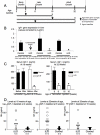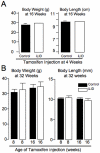Serum IGF-1 affects skeletal acquisition in a temporal and compartment-specific manner
- PMID: 21445249
- PMCID: PMC3060807
- DOI: 10.1371/journal.pone.0014762
Serum IGF-1 affects skeletal acquisition in a temporal and compartment-specific manner
Abstract
Insulin-like growth factor-1 (IGF-1) plays a critical role in the development of the growing skeleton by establishing both longitudinal and transverse bone accrual. IGF-1 has also been implicated in the maintenance of bone mass during late adulthood and aging, as decreases in serum IGF-1 levels appear to correlate with decreases in bone mineral density (BMD). Although informative, mouse models to date have been unable to separate the temporal effects of IGF-1 depletion on skeletal development. To address this problem, we performed a skeletal characterization of the inducible LID mouse (iLID), in which serum IGF-1 levels are depleted at selected ages. We found that depletion of serum IGF-1 in male iLID mice prior to adulthood (4 weeks) decreased trabecular bone architecture and significantly reduced transverse cortical bone properties (Ct.Ar, Ct.Th) by 16 weeks (adulthood). Likewise, depletion of serum IGF-1 in iLID males at 8 weeks of age, resulted in significantly reduced transverse cortical bone properties (Ct.Ar, Ct.Th) by 32 weeks (late adulthood), but had no effect on trabecular bone architecture. In contrast, depletion of serum IGF-1 after peak bone acquisition (at 16 weeks) resulted in enhancement of trabecular bone architecture, but no significant changes in cortical bone properties by 32 weeks as compared to controls. These results indicate that while serum IGF-1 is essential for bone accrual during the postnatal growth phase, depletion of IGF-1 after peak bone acquisition (16 weeks) is compartment-specific and does not have a detrimental effect on cortical bone mass in the older adult mouse.
Conflict of interest statement
Figures





Similar articles
-
Generation of a new congenic mouse strain to test the relationships among serum insulin-like growth factor I, bone mineral density, and skeletal morphology in vivo.J Bone Miner Res. 2002 Apr;17(4):570-9. doi: 10.1359/jbmr.2002.17.4.570. J Bone Miner Res. 2002. PMID: 11918215
-
Bone-Derived IGF-I Regulates Radial Bone Growth in Adult Male Mice.Endocrinology. 2023 Jun 26;164(8):bqad104. doi: 10.1210/endocr/bqad104. Endocrinology. 2023. PMID: 37406213 Free PMC article.
-
The ternary IGF complex influences postnatal bone acquisition and the skeletal response to intermittent parathyroid hormone.J Endocrinol. 2006 May;189(2):289-99. doi: 10.1677/joe.1.06657. J Endocrinol. 2006. PMID: 16648296
-
A model for tissue-specific inducible insulin-like growth factor-I (IGF-I) inactivation to determine the physiological role of liver-derived IGF-I.Endocrine. 2002 Dec;19(3):249-56. doi: 10.1385/ENDO:19:3:249. Endocrine. 2002. PMID: 12624424 Review.
-
A transgenic model to determine the physiological role of liver-derived insulin-like growth factor I.Minerva Endocrinol. 2002 Dec;27(4):299-311. Minerva Endocrinol. 2002. PMID: 12511852 Review.
Cited by
-
Rodent models of aging bone: an update.Curr Osteoporos Rep. 2011 Dec;9(4):219-28. doi: 10.1007/s11914-011-0074-z. Curr Osteoporos Rep. 2011. PMID: 21918858 Review.
-
The effect of dipeptidyl peptidase-IV inhibition on bone in a mouse model of type 2 diabetes.Diabetes Metab Res Rev. 2014 Mar;30(3):191-200. doi: 10.1002/dmrr.2466. Diabetes Metab Res Rev. 2014. PMID: 24023014 Free PMC article.
-
IGF-1 Regulates Vertebral Bone Aging Through Sex-Specific and Time-Dependent Mechanisms.J Bone Miner Res. 2016 Feb;31(2):443-54. doi: 10.1002/jbmr.2689. Epub 2015 Sep 3. J Bone Miner Res. 2016. PMID: 26260312 Free PMC article.
-
Independent evolution toward larger body size in the distinctive Faroe Island mice.G3 (Bethesda). 2021 Jan 18;11(1):jkaa051. doi: 10.1093/g3journal/jkaa051. G3 (Bethesda). 2021. PMID: 33561246 Free PMC article.
-
Low levels of plasma IGF-1 inhibit intracortical bone remodeling during aging.Age (Dordr). 2013 Oct;35(5):1691-703. doi: 10.1007/s11357-012-9469-8. Epub 2012 Sep 14. Age (Dordr). 2013. PMID: 22976122 Free PMC article.
References
-
- Canalis E, Pash J, Varghese S. Skeletal growth factors. Crit Rev Eukaryot Gene Expr. 1993;3:155–166. - PubMed
-
- McCarthy TL, Centrella M, Canalis E. Regulatory effects of insulin-like growth factors I and II on bone collagen synthesis in rat calvarial cultures. Endocrinology. 1989;124:301–309. - PubMed
-
- Canalis E, Rydziel S, Delany AM, Varghese S, Jeffrey JJ. Insulin-like growth factors inhibit interstitial collagenase synthesis in bone cell cultures. Endocrinology. 1995;136:1348–1354. - PubMed
-
- Rydziel S, Delany AM, Canalis E. Insulin-like growth factor I inhibits the transcription of collagenase 3 in osteoblast cultures. J Cell Biochem. 1997;67:176–183. - PubMed
-
- Holly J. Physiology of the IGF system. Novartis Found Symp 262: 19–26; disussion. 2004:26–35. 265-268. - PubMed
Publication types
MeSH terms
Substances
Grants and funding
LinkOut - more resources
Full Text Sources
Molecular Biology Databases
Research Materials
Miscellaneous

